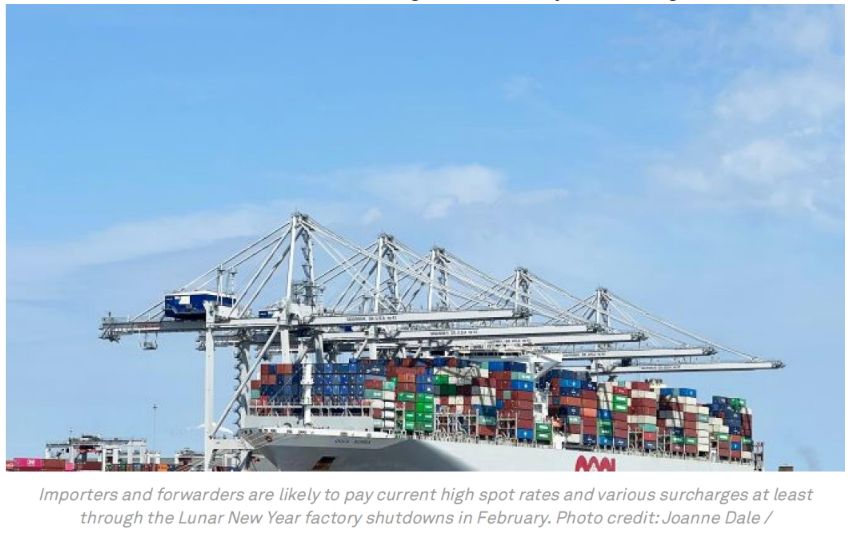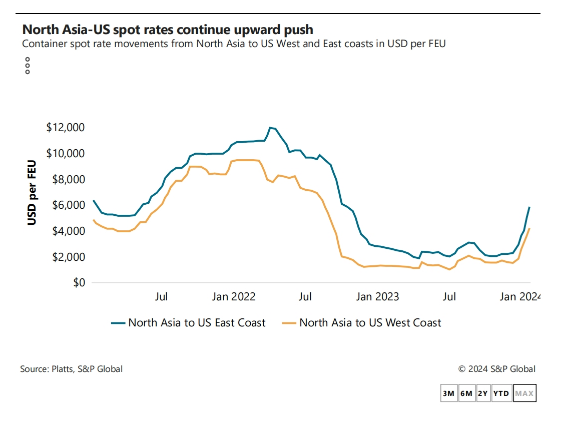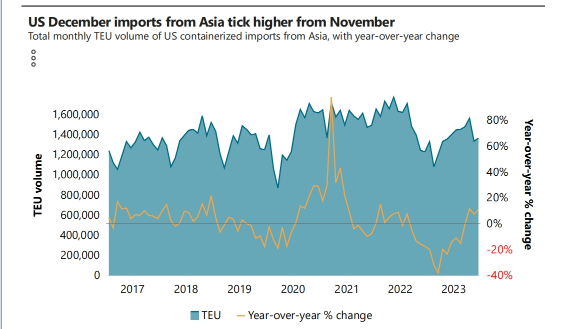Trans-Pacific carriers hit customers with higher rates,flurry of surcharges

Jan 17, 2024, 1:20 PM EST
Importers and forwarders on Asia-US trades are paying sharply higher spot rates this week after carriers implemented previously announced Jan.15 general rate increases (GRIs) and imposed a peak-season surcharge (PSS) on shipments to both the West and East coasts.
Additionally, importers shipping to the East Coast via the Panama or Suez canals, or around the southern tip of Africa, are subject to additional surcharges.
The new rate increases could be stickier than they would have normally been due to the knock-on effects of carrier disruptions linked to the militant attacks on shipping in the Red Sea, forcing carriers into longer routings around southern Africa.
The increased costs for shipping containers from Asia to the US are expected to persist through the beginning of the Lunar New Year holidays on Feb.10. US imports from Asia in December increased to 1.37 million TEUs from 1.34 million TEUs in November, according to PIERS, a sister company of the Journal of Commerce within S&P Global. That signals the beginning of the rush to ship product from Asia before many factories close for a week or two for the holidays.
Spot rates from Asia to the US West Coast were pegged at $4,200 per FEU as of Jan. 16, up 15% on the week, according to Platts, also owned by S&P Global. Rates to the
East Coast were $5,900 per FEU, up 17%.

No escaping surcharges
Carriers and non-vessel-operating common carriers (NVOs) say most importers are paying some type of surcharge.
“This is not just ‘the little guys are getting hit’ type of surcharge,” a carrier executive who spoke on the condition of anonymity told the Journal of Commerce. A number of importers and NVOs are paying a PSS of several hundred dollars per container, according to Christian Sur, executive vice president of ocean freight contract logistics at Unique Logistics International. PSSs are generally associated with the period from August through October when most of the Christmas merchandise enters the country, but that’s not the case today, he said.
“PSS is not just for the summer months,” Sur said. “It’s whenever volumes increase or [vessel capacity] or equipment are lacking.”The PSSs are the arriers’response to the overall surge in demand in the eastbound trans-Pacific and are being imposed on both Asia-West Coast routes and East Coast routes.
“This is a pre-Chinese New Year surge,” said Kurt McElroy, executive vice president at forwarder Kerry Apex. “I know the carriers are trying to have discussions with their BCOs [beneficial cargo owners] about the peak season surcharges.”
While the PSSs are being charged on shipments to both the West and East coasts, the surcharges levied on shipments through the Panama and Suez canals apply only to services that call at East Coast ports. Importers and NVOs say they are already concerned those surcharges are getting out of hand.
David Bennett, chief commercial officer at the forwarder Farrow, said there is no consistency among the carriers as to how much they are charging for the disruptions at the canals or even what they are calling the surcharges. “They are all over the map,” he said.
“Panama Canal surcharge,” “Suez Canal surcharge,”“war-risk surcharge,” “Panama Canal adjustment factor” and “Panama Canal low-water surcharge,” are some of the labels carriers are giving the charges, Bennett said.
A second carrier executive who did not want to be identified said the surcharges are warranted because of the equipment and vessel space shortages as cargo volumes build during the pre-Lunar New Year rush.
“It’s not a money grab,” the source said. “There’s no room, especially because of Feb.10 [the start of Lunar New Year].”
The first carrier executive said it would require a “large spreadsheet” to detail exactly what surcharges each trans-Pacific carrier is levying on its customers and the amount of each surcharge. Also, carriers differ as to whether the surcharges are included in one all-inclusive spot rate, or whether the surcharges are being added separately to the customer’s bill.
“It is a very dynamic and fluid situation,” he said, adding the uncertainty extends to how long the surcharges will be levied.
Volume boost at load ports
Bookings at Asian load ports are strong right now and are likely to remain strong through the pre-Lunar New Year rush, said Bennett. “I felt a surge developing in the last week of December,” he said. “Now it’s more than I anticipated.”
In addition to growing cargo volumes, equipment shortages have developed at some Asian load ports. The shortages are being aggravated by a diversion of vessels from
the Suez Canal to the much longer route around the southern tip of Africa amid the uncertain security situation in the Red Sea. The developments are removing effective capacity from the Asia-East Coast trade.

Some importers had been taking a wait-and-see approach as to whether vessels would return to the Suez routing, said Benton Kauffman, senior vice president at forwarder DSV. However, now that the US is responding with direct strikes on the Houthis, it feels as though “we’re on the cusp of panic” that can accelerate through the Lunar New Year, he said.
“A lot of people were caught off guard by this,” said Kauffman. “Importers took too long to act as they thought it would resolve itself more quickly.”
Some shippers are now double-booking space — booking the same container with their forwarder and their ocean carrier— due to concerns about the situation in the Red Sea. Some shipments are being rolled to a later voyage at origin, although rolling is not yet widespread, Kauffman said.
Spot rates slightly less than earlier estimates
Given the lack of consistency among carriers in their pricing, it is best to give a range of prices in the eastbound trans-Pacific rather than quoting exact amounts, carriers and NVOs say. In December when carriers filed the spot rates and, in the case of NVOs,freight-all-kinds (FAK) rates that would take effect on Jan.15, they were aiming at $5,000 per FEU to the West Coast and $7,000 to the East Coast.
While carriers are not reaching those numbers, customers are paying spot rates in the mid-$4,000s per FEU to the West Coast and as high as $6,700 to $6,800 per FEU to the East Coast, McElroy said.
“Typically,rates settle around the same level,” he said. “A few carriers will take advantage of the Suez situation, but if they don’t get enough cargo, those rates will come down.”

